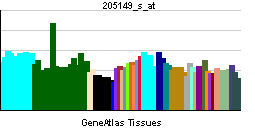CLCN4
| Chloride channel 4 | |||||||||||
|---|---|---|---|---|---|---|---|---|---|---|---|
| Identifiers | |||||||||||
| Symbols | CLCN4 ; CLC4; ClC-4; ClC-4A; MGC163150 | ||||||||||
| External IDs | Template:OMIM5 Template:MGI HomoloGene: 68207 | ||||||||||
| |||||||||||
| RNA expression pattern | |||||||||||
 | |||||||||||
 | |||||||||||
| More reference expression data | |||||||||||
| Orthologs | |||||||||||
| Template:GNF Ortholog box | |||||||||||
| Species | Human | Mouse | |||||||||
| Entrez | n/a | n/a | |||||||||
| Ensembl | n/a | n/a | |||||||||
| UniProt | n/a | n/a | |||||||||
| RefSeq (mRNA) | n/a | n/a | |||||||||
| RefSeq (protein) | n/a | n/a | |||||||||
| Location (UCSC) | n/a | n/a | |||||||||
| PubMed search | n/a | n/a | |||||||||
Chloride channel 4, also known as CLCN4, is a human gene.[1]
The CLCN family of voltage-dependent chloride channel genes comprises nine members (CLCN1-7, Ka and Kb) which demonstrate quite diverse functional characteristics while sharing significant sequence homology. Chloride channel 4 has an evolutionary conserved CpG island and is conserved in both mouse and hamster. This gene is mapped in close proximity to APXL (Apical protein Xenopus laevis-like) and OA1 (Ocular albinism type I), which are both located on the human X chromosome at band p22.3. The physiological role of chloride channel 4 remains unknown but may contribute to the pathogenesis of neuronal disorders.[1]
References
Further reading
- Schnur RE, Wick PA (1995). "Intragenic TaqI restriction fragment length polymorphism (RFLP) in CICN4, between the loci for X-linked ocular albinism (OA1) and microphthalmia with linear skin defects syndrome (MLS)". Hum. Genet. 95 (5): 594–5. PMID 7759088.
- van Slegtenhorst MA, Bassi MT, Borsani G; et al. (1994). "A gene from the Xp22.3 region shares homology with voltage-gated chloride channels". Hum. Mol. Genet. 3 (4): 547–52. PMID 8069296.
- Maruyama K, Sugano S (1994). "Oligo-capping: a simple method to replace the cap structure of eukaryotic mRNAs with oligoribonucleotides". Gene. 138 (1–2): 171–4. PMID 8125298.
- Dinulos MB, Bassi MT, Rugarli EI; et al. (1996). "A new region of conservation is defined between human and mouse X chromosomes". Genomics. 35 (1): 244–7. doi:10.1006/geno.1996.0347. PMID 8661129.
- Suzuki Y, Yoshitomo-Nakagawa K, Maruyama K; et al. (1997). "Construction and characterization of a full length-enriched and a 5'-end-enriched cDNA library". Gene. 200 (1–2): 149–56. PMID 9373149.
- Lamb FS, Clayton GH, Liu BX; et al. (1999). "Expression of CLCN voltage-gated chloride channel genes in human blood vessels". J. Mol. Cell. Cardiol. 31 (3): 657–66. doi:10.1006/jmcc.1998.0901. PMID 10198195.
- Kawasaki M, Fukuma T, Yamauchi K; et al. (1999). "Identification of an acid-activated Cl(-) channel from human skeletal muscles". Am. J. Physiol. 277 (5 Pt 1): C948–54. PMID 10564087.
- Strausberg RL, Feingold EA, Grouse LH; et al. (2003). "Generation and initial analysis of more than 15,000 full-length human and mouse cDNA sequences". Proc. Natl. Acad. Sci. U.S.A. 99 (26): 16899–903. doi:10.1073/pnas.242603899. PMID 12477932.
- Wang T, Weinman SA (2004). "Involvement of chloride channels in hepatic copper metabolism: ClC-4 promotes copper incorporation into ceruloplasmin". Gastroenterology. 126 (4): 1157–66. PMID 15057754.
- Suzuki Y, Yamashita R, Shirota M; et al. (2004). "Sequence comparison of human and mouse genes reveals a homologous block structure in the promoter regions". Genome Res. 14 (9): 1711–8. doi:10.1101/gr.2435604. PMID 15342556.
- Picollo A, Pusch M (2005). "Chloride/proton antiporter activity of mammalian CLC proteins ClC-4 and ClC-5". Nature. 436 (7049): 420–3. doi:10.1038/nature03720. PMID 16034421.
- Huang L, Cao J, Wang H; et al. (2006). "Identification and functional characterization of a voltage-gated chloride channel and its novel splice variant in taste bud cells". J. Biol. Chem. 280 (43): 36150–7. doi:10.1074/jbc.M507706200. PMID 16129671.
- Littler DR, Assaad NN, Harrop SJ; et al. (2005). "Crystal structure of the soluble form of the redox-regulated chloride ion channel protein CLIC4". FEBS J. 272 (19): 4996–5007. doi:10.1111/j.1742-4658.2005.04909.x. PMID 16176272.
- Okkenhaug H, Weylandt KH, Carmena D; et al. (2006). "The human ClC-4 protein, a member of the CLC chloride channel/transporter family, is localized to the endoplasmic reticulum by its N-terminus". FASEB J. 20 (13): 2390–2. doi:10.1096/fj.05-5588fje. PMID 17023393.
| This protein-related article is a stub. You can help Wikipedia by expanding it. |